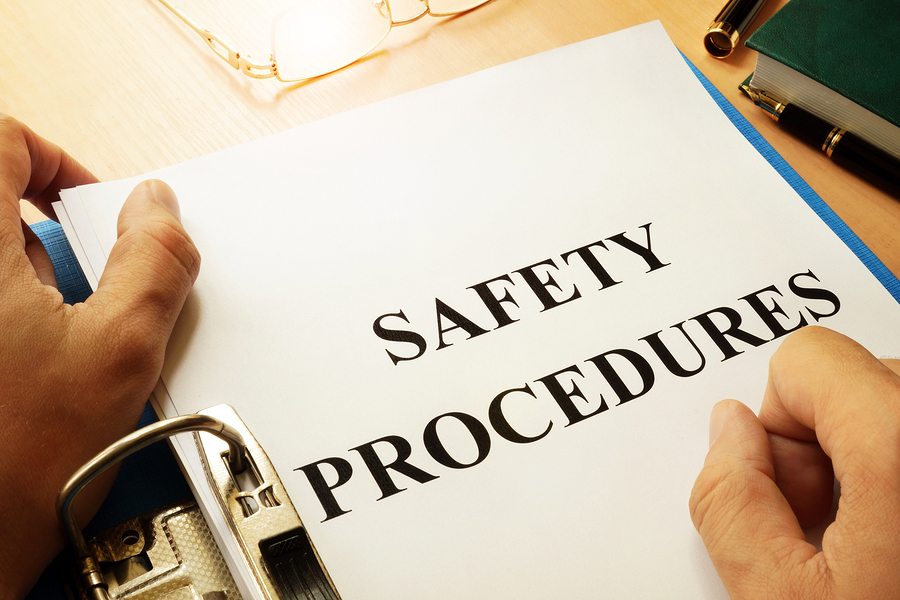by jeffp | Nov 20, 2017 | Workplace Safety

Office fires are responsible for approximately hundreds of deaths each year and thousands of injuries. That’s according to the Occupational Safety and Health Administration (OSHA), tracking workplace safety and hazards. OSHA identified inadequate prevention measures, inaccessible exits, and poor training likely contributed to these numbers. Many fires can be prevented and the right training can help employees escape in case of danger. Evaluating current fire prevention measures, equipping facility and staff with responsive equipment, and incorporating employee training can all help reduce risk and injury from office fires.
1. Evaluate
The first step in improving fire response and prevention is to inspect and evaluate the workspace for any potential hazards for causing fires or preventing escape. Be sure to check:
- Electrical wiring. Overuse of extension cords and power strips can lead to potential fire risk. They also create trip hazards. Seek safe and permanent solution for electrical needs.
- Storage. Flammable materials have special storage instructions for preventing fires. Establish safe storage and ventilation procedures around the office or job site.
- Smoking areas. Designated smoking areas and cigarette-butt collection containers reduce the risk of accidental fire.
- Tools and appliances. Some tools and appliances have greater electrical requirements which may contribute to electrical fires if used in an unsafe manner. Check for the UL safety mark before turning plugging tools and appliances into electrical sockets.
- Exits. Check for the proper number of building and room exits and clear for ease of use.
- Emergency lighting. Check emergency lighting for function.
After evaluating current measures and practices improvements and additions can be made.
2. Equip
Lighting, sprinkler systems and alarms, and fire extinguishers all contribute to workplace safety. Depending on the size and layout of a workplace a combination of safety measures may help reduce risk. Fire extinguishers are an affordable and simple way to improve employee safety and reduce the risk of fire.
Different types of fire extinguishers are available for fighting different types of potential fires in the workplace. Individual requirements will help determine the right type of fire extinguisher for the workspace:
- Type A: Fights fires made from wood and paper materials.
- Type B: Extinguishes fires caused by flammable liquids such as gasoline, oil, and industrial solvents.
- Type C: Fights electrical fires.
- Type D: Fights fires related to combustible metals like magnesium, potassium, and titanium.
- Type K: Fights kitchen and grease fires.
Follow the regular maintenance schedule to keep fire extinguishers operable and ready in case of fire. Maintain access to fire extinguishers at all times.
3. Train
Equipment and training go together. Teach staff on fire responsive measures and hold regular safety training to keep employees safe. Employee fire safety training can be structured to include training on:
- Finding and triggering fire alarms.
- Locating and identifying safe exits.
- Selecting and operating fire extinguishers.
Employers and staff should always place safety first. Train employees to evacuate any time they feel unsafe, the fire is too large, or exit may be threatened by remaining.
To learn more about workplace fire prevention and for other safety information, contact an agent. Fire prevention affects insurance premiums and coverage. Add safety measures and reduce risk. For more information about commercial fire insurance or for answers to insurance questions, call today.
by jeffp | Nov 15, 2017 | Workplace Safety

Small-business owners rely on strong employees. The challenge for nearly all is finding strong employees, to begin with. Today firms of all sizes are using creative strategies for attracting and retaining great talent. For many, this means unique vacation incentives and other tantalizing packages, yet often-overlooked is simply creating a safe work environment. A safe environment promotes well-being and productivity.
Insurance veteran David Quezada says it is important for management to prioritize safety. This protecting the workplace, staff, and any visitors. Mr. Chris Edmonds, the founder of The Purposeful Culture Group, concurs with thinking. Edmonds says managers ensuring a risk-free workplace will reap significant rewards. It is important organizations of any size to invest in safety and accountability measures. Safety should be the required standard.
They may be on to something. Research shows companies operating in positive, risk-free work-spaces outperform those working elsewhere. Customers respond well to safe employees, and the opposite holds true as well. Firms neglecting safety soon find the phone lines quiet.
Recent small-business research shows only 17% of employees receive adequate workplace safety training. That number is eclipsed by those without any training, a whopping 25% of respondents. Employees without training will have difficulty adhering to safety standards. Initial and ongoing safety training is recommended for companies of all sizes.
Edmonds underscored the importance of safety-related correlating safety with competence and security. Safe employees are shown to perform better. A culture of safety begins at the top and spreads throughout an organization. Safety classes, manuals, and other materials may be helpful for training and reference purposes. Safety is an ongoing conversation in which employees and management should be actively part. Respond to safety concerns swiftly.
Safety assessments are recommended to evaluate employee performance and knowledge of safety policies and procedures. Safety is an active consideration. An organization with a well-defined safety culture stands to gain. Safety always takes precedence over profits. Be ready to invest in tangible and intangible safety measures to improve workplace safety and morale. Safety is easily achieved with the right attitude and strategy.
Insurance-related topics have a surprisingly large bearing on health and finances. Call anytime for answers to insurance questions.
by jeffp | Oct 26, 2017 | Workplace Safety

Most people go to work expecting a safe workplace. OSHA messages abound recommending safety tips and encouraging reporting of safety issues. Despite this, a large number of incidents occur each year, sometimes serious. To explain this, two groups conducted studies into workplace safety. The studies each reached a similar result: the solution to workplace safety lay in proper supervision.
The first study, conducted by the National Safety Council, was published in volume 45 of the Journal of Safety and Security. This study discovered a large number of younger employees unwilling to report safety issues due to real or perceived minimal workplace influence. Recognizing safety issues may also mean awkward interactions with supervisors, a refusal to work in a hazardous environment, or contacting safety entities.
Campaigns encouraging younger workers to recognize and report safety issues have been minimally successful, with many choosing to work rather than stir things up. Often, young workers hope someone else reports safety issues before an incident, or the safety hazard will resolve itself.
This sense of having little influence stems from age and experience. Many younger works assume any reports will go ignored or will amount to very little due to influence. Some employees find strength in each other and may report safety issues after building consensus.
The second set of results comes from a study from the AFL-CIO-affiliated Center for Construction Research and Training. This study surveyed construction workers, coming to similar conclusions. According to this study, construction workers may leave injuries unreported on the job site for many reasons. Of the 235 construction workers surveyed, 27% responded with having left one or more injury unreported.
Of the unreported injuries, over 70% went so because the worker involved deemed the injury “too small”. Other reasons for leaving injuries unreported included:
- Becoming injured is part of the job
- Avoiding appearing weak
- The problem can be corrected at home
- Unsure if the injury is work-related
- Fear of losing a job or contract
- Lacking paid time off to visit a medical professional
- Keeping other work-related benefits
Regardless of size, injuries should be reported. Minor injuries left untreated may lead to greater problems later on. Some injuries will go unnoticed for months or years following an incident. Report all issues to safety personnel so they can make the decision. Unreported issues are bad for the company and staff. In the long run, untreated injuries may cost both parties far more than initial treatment or some rest.
According to the International Journal of Occupational Safety and Ergonomics, Volume 19, Number 1, the solution may lie in creating a culture of communication in the workplace. This method, also called positive error management encourages the sharing of near-accidents with management as a tool for learning instead of punishment. Learning how to avoid future accidents can help the company more than punitive actions.
Daily, open communication between management and junior staff helps employees feel comfortable reporting safety issues and other hazards. Supervisors can demonstrate they care by asking employees to share concerns before someone is harmed in the workplace.
This will likely send a powerful message to both new and existing employees. A supervisor has the ability to back up the talk with motivating actions that will get the point across. Encourage open communication and work toward a safer work environment.
Return for more great tips and info about insurance topics affecting health, home, and the pocketbook. For any insurance-related questions, call anytime.
by jeffp | Oct 13, 2017 | Workplace Safety

Supervisors have a lot to keep track of. Management means more than assigning work. Managers maintain a list of responsibilities affecting workplace safety. Effective supervisors create safe environments through action and training. Staff trained to spot and report safety issues create a safer environment. To promote a safe environment for industry, apply the following methods to the workplace:
Staff Training
Encourage staff to locate hazards, maintain awareness, and perform work safely. Train staff on any protective equipment necessary, and label all steps for emergency response. Ensure completion of all mandatory safety training courses, and keep accurate records.
Safe Methods
Supervisors are responsible for more than getting the job complete, it must be completed safely. Safe practices apply to careers from the office to construction. In some cases, managers may need to create methods to reduce risk in the workplace. Employees with open communication with a manager will be able to report any safety concerns.
Fast response to safety concerns builds trust and creates a safer environment. For situations beyond a manager’s control to resolve, take any immediate action necessary to keep worker’s safe. Report to higher management and follow-up until resolved.
Clear Hazards
The majority of workplace claims begin with an unsafe environment. Managers training staff to spot safety hazards and remove them to see reduced workplace-accidents. Once hazards are located, take any proper safety and removal measures. Prevent further employee contact with hazards until resolution.
Follow-Up on Claims and Reports
Effective managers investigate all reports of unsafe situations in the workplace. Inform staff members on the proper steps for reporting workplace incidents to the OMS (Occupation Medical Service). Stay compliant. The National Institute of Health (NIH) requires reporting of all workplace injuries. Working with OSHA, the OMS investigates and resolves workplace hazards and injuries. Address any official employee-claims forms promptly.
Encourage a Speedy Return
The longer employees remain away from the workplace, the less likely it is they will return at all. Encourage workers absent from the workplace due to injury to return to work as soon as medically cleared. Consider any physical limitations caused by injuries, limiting employee duties if possible. Keeping teams motivated, safe and effective helps managers succeed.
A lot can happen in a workplace. Add the human factor and anything is possible. The right training, communication, and processes can help keep employees safe and insurance costs low. Talk to an insurance agent today for tips on keeping rates low through workplace safety.
Check often for more valuable information about insurance topics affecting health and wallet. Have a topic to share? Please send any topic requests. For any insurance-related questions contact an agent today.
by jeffp | Oct 10, 2017 | Workplace Safety

The recent shooting in Vegas is a grim reminder: active shooter scenarios occur all too often. According to the Department of Homeland security, over 1500 workplace shootings happen in the past year. Many of these shooters are on destructive paths, bent on hurting as many people as possible.
The National Safety Council recommends active shooter preparedness become part of workplace safety plans. These strategies can help workers survive an active shooter:
1. Run
Run as quickly as possible. Take the opportunity and encourage others to as well. There may be active gunfire. Avoid any unnecessary risks and leave the area.
Emergency responders may already be on-scene. For safety, keep hands visible and follow instructions from emergency personnel. Keep hands above the head. Relay any information about the shooter to police and rescue personnel.
2. Hide
Unsure of shooter location, blocked from exiting, or otherwise unable to leave the area? Hide. Lockable rooms and doors make good barriers. Place objects against the door for added security.
Turn electronic devices off. Workplace shooters may hear a ringing phone, text message, or other audible tones. Turn phones and other devices off.
3. Fight
Shooters may be too close to run or may force action. As a last option, fight active shooters and overcome them. Attack and aim for weak areas such as the neck, groin, and face. Anything in the area becomes a weapon of opportunity. Chairs, extinguishers, and other office supplies are fair game. Subdue a shooter as best possible and let law enforcement handle the rest.
Safety and security are important. Speak an agent today about this or other insurance-related material.
by jeffp | Sep 26, 2017 | Workplace Safety

Too much computer, phone, or e-reader use may harm your vision. Computer Vision Syndrome (also referred to as digital or electronic eyestrain) results from prolonged use of electronic devices. This concerns the average American worker who according to the American Optometry Association averages seven hours per day using a computer or electronic device. CVS has many painful symptoms. You may experience a single symptom or any combination. Symptoms of Computer Vision Syndrome include:
- Eyestrain
- Migraines
Dry eyes
- Blurry vision
- Head, neck, and shoulder pain
- Vision loss, and more
Poor lighting, screen proximity, and screen glow can further exacerbate these conditions. Persons with poor posture and those with poor baseline vision may be at increased risk for CVS. For most people, CVS symptoms and discomfort cease after time away from a computer or device screen. Yet for some, symptoms continue long after. American Optometry Association (AOA) warns these symptoms, left untreated, may cause further damage.
What to do About Eyestrain
Evidence of CVS is detectable with a comprehensive eye exam. If diagnosed with CVS your eye-care professional will recommend the best treatment plan for you. Treatments vary due to symptom and patient but often, the following recommendations may help alleviate eyestrain:
- Train your eyes. Vision therapy can help train and improve how your eyes and brain interact, reducing the workload.
- Position your screen. Keep your computer, tablet, phone and other devices at the right distance and angle from your eyes. The best position for your screen is 15-20 degrees below eye level and 20-28 inches from your eyes.
- Avoid the glare. Avoid screen glare by closing any blinds or drapes on your windows. Use lower watt bulbs in lamps or overhead lights. Anti-glare screens are available as well.
- Sit upright. Keep your chair upright and your feet flat on the floor.
- Look away. Try to budget 15 minutes every two hours for a screen break. This can help your eyes recover. You can also practice the use 20-20-20 method. Every 20 minutes look 20 feet away for 20 seconds.
- Blink! Blinking regularly helps maintain eye moisture, reducing fatigue.
We’re always on the lookout for great information about insurance topics that may impact health and finances. If you have any insurance-related questions be sure to reach out to us.








